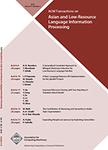版权所有:内蒙古大学图书馆 技术提供:维普资讯• 智图
内蒙古自治区呼和浩特市赛罕区大学西街235号 邮编: 010021

作者机构:School of Computing National University of Singapore Kent Ridge 117543 Singapore State Key Lab. of Intelligent Technology and Systems Department of Electronic Engineering Tsinghua University Beijing 100084 P. R China
出 版 物:《ACM Transactions on Asian Language Information Processing》 (ACM Trans. Asian Lang. Inf. Process.)
年 卷 期:2002年第1卷第4期
页 面:297-309页
学科分类:0810[工学-信息与通信工程] 0808[工学-电气工程] 08[工学] 0812[工学-计算机科学与技术(可授工学、理学学位)]
主 题:Algorithms Chinese character recognition contextual postprocessing efficiency of candidate set forward-backward search Languages Performance statistical language model
摘 要:It is crucial to use contextual information to improve the recognition accuracy of Chinese script in an offline, handwritten Chinese character-recognition system. However, with the increase in the number of candidates given by a character recognizer, contextual postprocessing using a word-based bigram is time-consuming. This article presents a novel contextual postprocessing method that integrates character-based bigram postprocessing with word-based bigram postprocessing in light of the complementary action between Chinese characters and Chinese words. On the basis of isolated character recognition, character-based bigram postprocessing using a forward-backward search is first executed on a big candidate set, which improves both the accuracy and efficiency of the candidate set (the cumulative accuracy of the top ten candidates is greatly boosted). Then, to further improve accuracy, word-based bigram postprocessing (WBP) is executed on a small candidate set. This method obtains high accuracy while paying attention to postprocessing speed at the same time. Experimental results for three Chinese scripts (about 66,000 characters in total) demonstrate the effectiveness of our method: character-based bigram postprocessing improves accuracy from 81.58% to 94.50%, and the cumulative accuracy of the top ten candidates rises from 94.33% to 98.25%. After WBP, 95.75% accuracy is achieved, which is equivalent to the accuracy of WBP executed on a big candidate set. However, our method is more than 100 times faster than that of WBP. © 2002, ACM. All rights reserved.